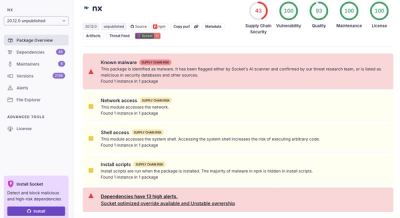
Security News
/Research
Wallet-Draining npm Package Impersonates Nodemailer to Hijack Crypto Transactions
Malicious npm package impersonates Nodemailer and drains wallets by hijacking crypto transactions across multiple blockchains.
pixi-factory
Advanced tools
A superset for creating and handling Pixi.js resources
npm install pixi.js pixi-factory
or
yarn add pixi.js pixi-factory
We recommend that you use Factory.* To avoid new method intentions, in addition to already containing everything that the library has.
With Factory.Sprite.* or new Sprite().* create and handle sprites in a more coherent way and with new features.
import * as PIXI from 'pixi.js';
import Factory from 'pixi-factory';
const app = new PIXI.Application();
document.body.appendChild(app.view);
app.loader.add('example', 'example.jpg').load((loader, resources) => {
const example = Factory.Sprite.create(new PIXI.Sprite(resources.example.texture), {
bump: true, // hability a collision properties
velocity: true, // hability a velocity base content
d20rpg: true, // hability a standard d20 rpg
content: {
// append or override content in a base sprite properties
x: 100,
y: 100,
},
});
console.log(example.velocity); // a velocity content
console.log(example.centerY); // a bump property
console.log(example.base); // a d20 rpg contents
app.stage.addChild(example);
// ...
});
The creation functions expect only a generic object with a key in string, so that the methods are not directly dependent on PIXI, being able to create external objects.
import Factory from 'pixi-factory';
const sprite = Factory.Sprite.create({ name: 'guest001' }, { content: { foo: 'bar' } });
The internal methods are also generic, waiting to receive the sprite that is being instantiated, modifying the internal methods. It is not a directly safe approach because it is changeable, but it makes it easy to handle objects without the need for an ECS.
import * as PIXI from 'pixi.js';
import Factory from 'pixi-factory';
const example = Factory.Sprite.create(new PIXI.Sprite(resources.example.texture), {
bump: true,
velocity: true,
d20rpg: true,
});
example.velocity.setVelocity(example, 10);
console.log(example.velocity.x); // 10
// or
example.velocity.x = 10;
example.velocity.y = 10;
All methods are available in the documentation
All methods starts with A_** (Actions) is called only once to execute effect, while those starting with the prefix E_** (Events) need to be called constantly on the same tick such as tracking motion events that are specific to each tick.
/* By default, this function takes 1 second to be fully generated, but it only needs to be called once to take effect. */
sprite.velocity.A_knockbackHit(sprite);
import * as PIXI from 'pixi.js';
import Factory from 'pixi-factory';
const app = new PIXI.Application();
document.body.appendChild(app.view);
app.loader.add('example', 'example.jpg').load((loader, resources) => {
const a = Factory.Sprite.create(new PIXI.Sprite(resources.example.texture), {
bump: true,
velocity: true,
d20rpg: true,
});
const b = Factory.Sprite.create(new PIXI.Sprite(resources.example.texture), {
bump: true,
velocity: true,
d20rpg: true,
});
app.stage.addChild(a);
app.stage.addChild(b);
app.ticker.add(() => {
/* Return a boolean */
console.log(a.base.E_hit(a, b, { type: 'rectangle' }));
});
});
With Factory.Group.* create and handle groups in a more coherent way and with new features.
import * as PIXI from 'pixi.js';
import Factory from 'pixi-factory';
// ...
function setup() {
const sprite = Factory.Sprite.create(new PIXI.Sprite(resources.example.texture));
const group = Factory.Group.create([sprite], { container: app.stage });
// or
const wolfs = Factory.Group.create(
[
['wolf1', Factory.Sprite.create(new PIXI.Sprite(resources.wolf.texture))],
['wolf2', Factory.Sprite.create(new PIXI.Sprite(resources.wolf.texture))],
['wolf3', Factory.Sprite.create(new PIXI.Sprite(resources.wolf.texture))],
],
{ container: app.stage, key: true },
);
console.log(wolfs.get('wolf1'));
}
It is possible to mutate objects in all ways to maintain coherent handling and not restrict sprites to the Factory
// example utilizing a pixi-controller package
import * as PIXI from 'pixi.js';
import Controller, { BUTTON, PLAYER } from 'pixi-controller';
import Factory from 'pixi-factory';
const app = new PIXI.Application();
document.body.appendChild(app.view);
app.loader.add('example', 'example.jpg').load((loader, resources) => {
const _example = Factory.Sprite.create(new PIXI.Sprite(resources.example.texture), {
bump: true,
velocity: true,
});
const group = Factory.Group.create([['example', _example]], { container: app.stage, key: true });
Controller.Mouse.prevent(BUTTON.RIGHT);
app.ticker.add(() => {
if (Controller.Keyboard.isKeyDown(...PLAYER.LEFT)) group.get('example').x -= 1;
if (Controller.Keyboard.isKeyDown(...PLAYER.RIGHT)) _example.x += 1;
if (Controller.Keyboard.isKeyDown(...PLAYER.UP)) group.get('example').y -= 1;
if (Controller.Keyboard.isKeyDown(...PLAYER.DOWN)) _example.y += 1;
Controller.update();
});
});
All interfaces and types are exported with the Utils namespace, thus being able to directly use the internal typing for your objects.
import Factory, { Utils } from 'pixi-factory';
const sprite: Utils.PIXISprite = Factory.Sprite.create(example, {
bump: true,
velocity: true,
d20rpg: true,
});
We recommend that you use
"strictNullChecks": falseintsconfig.jsonif you are usingTypescriptin your project.
It would be necessary to extend directly from PIXI.DisplayObject in addition to injecting some resources by default, polluting objects.
Standardizing the packages and the way to use pixi.js can bring future benefits, especially while using webpack/snowpack. If necessary, clone this project and run npm i && npm run build, this generating a index.js module and other extensions in the /lib folder. Consulting rollup.config.js for other options.
FAQs
A superset for creating and handling Pixi.js resources.
The npm package pixi-factory receives a total of 0 weekly downloads. As such, pixi-factory popularity was classified as not popular.
We found that pixi-factory demonstrated a not healthy version release cadence and project activity because the last version was released a year ago. It has 1 open source maintainer collaborating on the project.
Did you know?

Socket for GitHub automatically highlights issues in each pull request and monitors the health of all your open source dependencies. Discover the contents of your packages and block harmful activity before you install or update your dependencies.

Security News
/Research
Malicious npm package impersonates Nodemailer and drains wallets by hijacking crypto transactions across multiple blockchains.

Security News
This episode explores the hard problem of reachability analysis, from static analysis limits to handling dynamic languages and massive dependency trees.

Security News
/Research
Malicious Nx npm versions stole secrets and wallet info using AI CLI tools; Socket’s AI scanner detected the supply chain attack and flagged the malware.